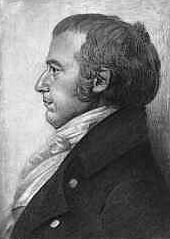Robert Goodloe Harper
Robert Goodloe Harper | |
|---|---|
 | |
| United States Senator from Maryland | |
| In office February 5, 1816 – December 6, 1816 | |
| Preceded by | Samuel Smith |
| Succeeded by | Alexander C. Hanson |
| Member of the U.S. House of Representatives from South Carolina's 5th district | |
| In office February 9, 1795 – March 4, 1801 | |
| Preceded by | Alexander Gillon |
| Succeeded by | William Butler |
| Chairman of the House Ways and Means Committee | |
| In office 1797 – 1800 | |
| Preceded by | William Loughton Smith |
| Succeeded by | Roger Griswold |
| Member of the South Carolina House of Representatives from Spartanburg County | |
| In office November 24, 1794 – February 9, 1795 | |
| Succeeded by | Henry Wells |
| Personal details | |
| Born | January 1765 Fredericksburg, Virginia |
| Died | January 14, 1825 (aged 59–60) Baltimore, Maryland |
| Political party | Federalist |
| Other political affiliations | Anti-Administration |
| Military service | |
| Allegiance | |
| Branch/service | United States Army |
| Rank | Major General |
| Battles/wars | War of 1812 |
Robert Goodloe Harper (January 1765 – January 14, 1825), a Federalist, was a member of the United States Senate from Maryland, serving from January 1816 until his resignation in December of the same year. He also served in the South Carolina House of Representatives (1790–1795), the U.S. House of Representatives from South Carolina (1795–1801), and in the Maryland State Senate. He is best remembered for the phrase, "Millions for defense, but not one cent for tribute."[1] The town of Harper, Liberia is named after him.
Early life
Harper, the fifth child and first son of Jesse Harper (1733 - ?) and Emily Diana Goodloe (1734–1788) was born near Fredericksburg, Virginia in January 1765 and moved with his parents to Granville, North Carolina around 1769. He received his early education at home and later attended grammar school. At the age of fifteen, Harper joined a volunteer corps of Cavalry and served in the American Revolutionary Army. He made a surveying tour through Kentucky and Tennessee in 1783, and graduated from the College of New Jersey (now Princeton University) in 1785. He studied law in Charleston, South Carolina, teaching school at the same time, and was admitted to the bar in 1786. He commenced practice in the Ninety-Sixth District of South Carolina, moving back to Charleston, S.C. in 1789.
On 7 May 1800, Harper married Catherine Carroll in Anne Arundel Co, Maryland, the daughter of Charles & Mary (Darnall) Carroll.
Robert had a least 4 children with Catherine:
- Charles Carroll Harper, m. Charlotte Hutchinson Cheffelle
- Richard Caton Harper
- Robert Goodloe Harper, Jr
- Emily Louisa Harper, m. William Clapham Pennington.
Political career in South Carolina
Harper was a member of the South Carolina House of Representatives from 1790 until 1795, at which time he was elected from South Carolina to the Third Congress to fill the vacancy caused by the death of Alexander Gillon. He was reelected to the Fourth, Fifth, and Sixth Congresses but was an unsuccessful candidate for reelection in 1800 to the Seventh Congress, serving as a U.S Representative from February 9, 1795 to March 1801. While in Congress, he was the chairman of the Committee on Ways and Means in the Fifth and Sixth Congresses. Harper was one of the managers appointed by the House of Representatives in 1798 to conduct the impeachment proceedings against William Blount.
Political career in Maryland
Harper moved to Baltimore, Maryland, and engaged in the practice of law. He served in the War of 1812, attaining the rank of major general. He assisted in organizing the Baltimore Exchange Co. in 1815 and was a member of the first board of directors. He then became a member of the Maryland State Senate, and was later elected from Maryland to the United States Senate for the term beginning March 4, 1815, serving from January 1816 until December 1816, when he resigned. He was an unsuccessful Federalist candidate for Vice President in the 1816 election. He also received one electoral vote for Vice President in the 1820 election.
Retirement
Harper traveled extensively in Europe in 1819 and 1820. He took a prominent part in the ceremonies on the occasion of Lafayette’s visit to Baltimore in 1824. He died in Baltimore on January 14, 1825, and was initially interred in the family burial ground on his estate, ”Oakland”, and later reburied in Greenmount Cemetery in Baltimore.
References
- American National Biography Papenfuse, Eric.
- The Evils of Necessity: Robert Goodloe Harper and the Moral Dilemma of Slavery; Cox, Joseph.
- Champion of Southern Federalism: Robert Goodloe Harper of South Carolina. Port Washington, N.Y.: Kennikat Press, 1972.
- United States Congress. "Robert Goodloe Harper (id: H000225)". Biographical Directory of the United States Congress.
- 1765 births
- 1825 deaths
- American people of the War of 1812
- Maryland State Senators
- Members of the South Carolina House of Representatives
- Members of the United States House of Representatives from South Carolina
- People from Fredericksburg, Virginia
- United States Army generals
- United States Senators from Maryland
- United States vice-presidential candidates, 1816
- United States vice-presidential candidates, 1820
- South Carolina Federalists
- Maryland Federalists
- Federalist Party United States Senators

